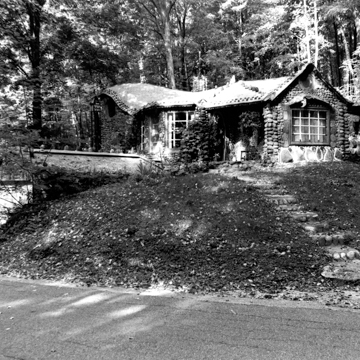In the early decades of the twentieth century, as Wisconsin’s logging industry waned, many people surveyed the state’s seemingly worthless cutover lands with dismay. But Wilmot Swanson, a woodsman and trapper, saw an opportunity to create a Rustic retreat, a whimsical fantasy world where the woods had been. Whether by design or serendipity, Swanson produced a charming work of folk art. Arriving in 1920, he cleared the remains of a defunct lumber camp and began building a house for himself and the first of several tourist log cabins. (The A-frame cabin is a more recent addition to the complex.) He later used rubble stone of various colors and shapes to create free-form buildings. To enhance the resort’s fairy-tale atmosphere, Swanson erected elfin gates and turnstiles, rock benches, and stone arches along paths that wandered over 127 acres.
His masterpiece was the cobblestone Gingerbread House created in the early 1950s. Looking like an illustration for the Brothers Grimm, the house begins with a foundation of what he called teardrops, between which rise blossoms made of red and purple stones with concrete stems. Above the foundation, cobblestones project from the vertical plane, while rows of stone gumdrops, fashioned from painted cobbles, accent the undulating roofline. Round windows with scalloped surrounds, a lancet doorway formed by bent tree limbs, and a lantern-like chimney add to the fantastical design. Above one window, the open wings of a bird in flight, sculpted in mortar and stone, form an awning, with the bird’s head and beak functioning as a birdhouse. The Gingerbread House interior is a fantasy in wood. A knobby burl forms a chandelier, pine knots become picture frames, and tree roots hold up shelves. All across the country, resort developers put up Rustic lodges and cabins made of cobblestone and knotty pine, but few showed the imagination evident in Swanson’s elaborate creation.


